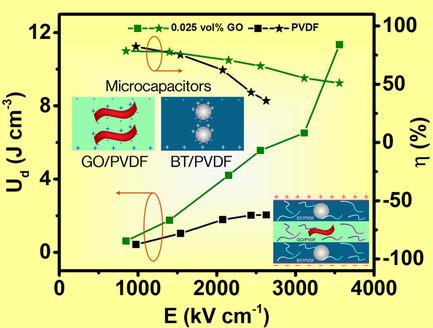当前位置:
X-MOL 学术
›
Energy Technol.
›
论文详情
Our official English website, www.x-mol.net, welcomes your feedback! (Note: you will need to create a separate account there.)
Unveiling the Role of Graphene Oxide as an Interface Interlocking Ingredient in Polyvinylidene Fluoride‐Based Multilayered Thin‐Film Capacitors for High Energy Density and Ultrafast Discharge Applications
Energy Technology ( IF 3.8 ) Pub Date : 2021-01-22 , DOI: 10.1002/ente.202000905 Prateek Prateek 1 , Ritamay Bhunia 2, 3 , Arnab Sarkar 4 , Sandeep Anand 4 , Ashish Garg 2, 5 , Raju Kumar Gupta 1, 5, 6
Energy Technology ( IF 3.8 ) Pub Date : 2021-01-22 , DOI: 10.1002/ente.202000905 Prateek Prateek 1 , Ritamay Bhunia 2, 3 , Arnab Sarkar 4 , Sandeep Anand 4 , Ashish Garg 2, 5 , Raju Kumar Gupta 1, 5, 6
Affiliation

|
Rising energy storage demands have accelerated the research to develop highly efficient dielectrics, such as polymer nanocomposites for capacitor applications. Herein, high energy and power density in dielectric composites via incorporating a large number of hetero‐interfaces and microcapacitors driven by interfacial polarization for thin‐film‐based flexible polymer capacitors are demonstrated. The barium titanate (BT) nanoparticles (NPs) and graphene oxide (GO) nanosheets are selectively localizing in the outer and middle layers, respectively. The BT/polyvinylidene fluoride (PVDF) as a “hard layer” helps in blocking the propagation of the electrical tree. The strong interaction between GO and PVDF in the GO/PVDF layer improves the interfacial polarization through formation of microcapacitors. Also, the confinement of the conduction charges simultaneously enhances the dielectric constant and breakdown strength. Thus, the GO nanofillers to work as both “soft layer” and “hard layer” are designed, and the energy density is improved to 11.4 J cm−3 at 3617 kV cm−1, ≈650% higher than that of commercially available biaxially oriented polypropylene (BOPP). Also, an ultrafast discharge time of 0.37 μs as compared to 2.8 μs for BOPP is achieved. These attributes make NP‐BaTiO3/nano‐GO/PVDF trilayered capacitors a suitable and promising candidate for the next‐generation flexible thin‐film dielectric capacitors.
中文翻译:

在高能量密度和超快放电应用的基于聚偏二氟乙烯的多层薄膜电容器中揭示氧化石墨烯作为界面互锁成分的作用
不断增长的储能需求加速了开发高效电介质(例如用于电容器应用的聚合物纳米复合材料)的研究。在本文中,通过将大量极化界面驱动的异质界面和微电容器结合到薄膜基柔性聚合物电容器中,证明了介电复合材料具有高能量和功率密度。钛酸钡(BT)纳米颗粒(NPs)和氧化石墨烯(GO)纳米片分别选择性地位于外层和中间层。BT /聚偏二氟乙烯(PVDF)作为“硬层”有助于阻止电树的传播。GO / PVDF层中GO和PVDF之间的强相互作用通过形成微电容器改善了界面极化。还,导电电荷的限制同时提高了介电常数和击穿强度。因此,设计了既可以用作“软层”又可以用作“硬层”的GO纳米填料,并将能量密度提高到11.4 J cm在3617 kV cm -1下为-3,比市售双轴取向聚丙烯(BOPP)高≈650%。此外,与BOPP的2.8μs相比,实现了0.37μs的超快放电时间。这些特性使NPBaTiO 3 / nano-GO / PVDF三层电容器成为下一代柔性薄膜介电电容器的合适和有希望的候选者。
更新日期:2021-01-22
中文翻译:

在高能量密度和超快放电应用的基于聚偏二氟乙烯的多层薄膜电容器中揭示氧化石墨烯作为界面互锁成分的作用
不断增长的储能需求加速了开发高效电介质(例如用于电容器应用的聚合物纳米复合材料)的研究。在本文中,通过将大量极化界面驱动的异质界面和微电容器结合到薄膜基柔性聚合物电容器中,证明了介电复合材料具有高能量和功率密度。钛酸钡(BT)纳米颗粒(NPs)和氧化石墨烯(GO)纳米片分别选择性地位于外层和中间层。BT /聚偏二氟乙烯(PVDF)作为“硬层”有助于阻止电树的传播。GO / PVDF层中GO和PVDF之间的强相互作用通过形成微电容器改善了界面极化。还,导电电荷的限制同时提高了介电常数和击穿强度。因此,设计了既可以用作“软层”又可以用作“硬层”的GO纳米填料,并将能量密度提高到11.4 J cm在3617 kV cm -1下为-3,比市售双轴取向聚丙烯(BOPP)高≈650%。此外,与BOPP的2.8μs相比,实现了0.37μs的超快放电时间。这些特性使NPBaTiO 3 / nano-GO / PVDF三层电容器成为下一代柔性薄膜介电电容器的合适和有希望的候选者。



























 京公网安备 11010802027423号
京公网安备 11010802027423号